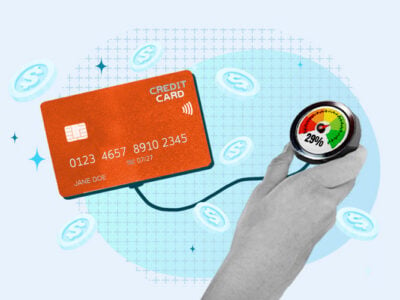Table of Contents
What is an interest rate?
Generally speaking, when you make a payment on a credit account, your lender will charge you an extra fee, which is known as interest. The amount that you have to pay is calculated as a percentage of the size of your debt.
The percentage of the debt that you have to pay in interest every year is known as your interest rate.
For an example of how interest rates work, imagine that you have a $1,000 loan with an interest rate of 4%. Your yearly interest on that loan will total $40 (because 4% of 1,000 is 40).
If you have to make monthly payments on that loan, that translates to paying about $3.33 per month in interest, because 40 divided by 12 is 3.33.
That example is a slight oversimplification—calculating interest can sometimes be a little more complicated than that in reality—but that’s essentially how it works. The complexities of interest rates are described in more detail below.
What’s the difference between an interest rate and an annual percentage rate?
If you’re applying for a loan or a credit card and you ask about its interest rate, your lender might refer to your credit card’s APR (annual percentage rate) when they answer.
The term APR means almost the same thing as interest rate, although it’s slightly broader in meaning. A credit account’s APR consists of its yearly interest rate plus any additional costs and fees that your lender charges you (such as origination fees that you have to pay to open the account).
This means that your credit account’s APR gives a more complete and accurate idea of how much you’ll be paying each year than its interest rate. However, in most cases, its interest rate will be the main component in its APR, so the two rates should be fairly close to each other.
Bank accounts also have interest rates
Interest can also refer to money that your bank pays you for keeping your savings with them.
When you deposit your money in a savings account, your bank will usually pay you a percentage of the money you left with them. This is because they benefit from keeping your money (for instance, it enables them to lend it to borrowers who need loans), so they pay interest to incentivize you to store your money with them.
Why do banks charge interest?
Banks and other lenders have to charge interest to make a profit. Lenders provide a service—allowing you to access more money than you’d be able to on your own. The interest that you pay (along with any other fees your lender adds on) is the price you pay for this service.
Charging interest also allows lenders to build up a cushion so that they’re able to weather financial losses (e.g., due to inflation or borrowers unexpectedly defaulting).
How does interest work?
Broadly speaking, interest works in the same way on both credit and savings accounts. In both cases, the interest you pay or receive is a percentage of the total amount you’re borrowing or saving.
How do loan and credit interest rates work?
Interest rates work in different ways depending on the type of loan you have. For instance, with installment loans (like mortgages and auto loans), you repay your debt plus interest every month over a pre-agreed schedule. However, with revolving credit accounts (like credit cards), you’re only charged interest if you don’t pay off your balance at the end of the billing period.
The interest you have to pay on credit depends on whether your lender charges you “compound” interest or “simple” interest.
How simple interest works
If your loan has simple interest, that means that your interest is always calculated based on the “principal”—the amount you borrowed and still owe.
For instance, if you borrow $1,000 and you have an interest rate of 4%, then every year you’ll pay $40 in interest. If the term of the loan was five years, then by the end you’ll have paid $200 in interest (because 40 times 5 is 200).
This is assuming that you don’t begin paying down the principal until the end of the loan term—if you start making payments earlier and your outstanding debt drops, your interest payments will drop as well.
How compound interest works
By contrast, if your loan has compound interest, that means that your interest is calculated based on both the principal and on the interest you’ve previously accrued. This means you’ll end up paying more in interest as time goes on (again, assuming that you don’t pay off either the principal or the interest until the end of the loan term).
For example, if you borrow $1,000 with an interest rate of 4%, then your first interest payment will be $40. But that interest payment will be added to the principal, bringing the amount that your interest is calculated from to $1,040.
Consequently, your second interest payment will be slightly higher at $41.60 (because 4% of 1,040 is 41.60). That will bring the amount that your interest is calculated from up to $1081.60, which means your next interest payment will be even higher, at $43.26.
As you can see, even if the difference is small in the beginning, every time your loan “compounds,” it will get a bit bigger. On loans with long terms, this can translate to many thousands of dollars over the lifetime of the loan.
How do savings account interest rates work?
Savings account interest rates work essentially the same way as credit account interest rates, but in reverse—they grow your money instead of draining it.
As mentioned, when you deposit funds in a bank, your bank will pay you a percentage of the money you left with them at set intervals. They’ll add it to the money that you deposited.
The amount of interest you’ll earn over the course of one year is known as your annual percentage yield (APY). The higher your APY, the more interest you’ll collect.
How compound interest works on savings accounts
Your APY includes compound interest, which is the interest you earn on interest. It works the same way on savings accounts as on credit accounts, but with the key difference that it actually works in your favor—as your interest payments grow and add to your principal, the amount of money that you earn gets larger and larger.
When your bank recalculates your new interest rate by factoring in the interest you accrued during the last period, that’s referred to as “compounding your interest.” Banks compound your interest at varying rates—e.g., once per day, month, quarter, or year. The more frequently they do, the higher your APY will be.
Currently, the average APY rate is 0.06%, although you can usually find much better rates by searching online for “best APY savings accounts.” 1 You can also put your savings into a certificate of deposit (CD) at a bank to get a higher APY. The catch is that you can’t touch your CD savings account for a prearranged period (e.g., 6, 18, or 60 months) without facing a penalty.
Average interest rates on loans
We’ve listed the average interest rates for the different types of loans below (as of October 2021): 2 3 4
- Mortgage (30-year fixed rate): ~3% (for a more accurate estimate, check the most recent mortgage rates reported by Freddie Mac)
- New car loan (4 years): 5.28%
- Personal loan (2 years): 9.58%
-
Federal student loans:
- Undergraduate: 3.73%
- Graduate and professional (Direct Unsubsidized Loans): 5.28%
- Parents, graduate and professional students (Direct PLUS loans): 6.28%
- Credit card: 14.61%
What is a high interest rate?
What’s considered a high interest rate depends on the type of credit account or loan you’re looking for. Loans come with different levels of risks for the lender, which translates to different interest rates.
Generally, an interest rate is considered high if it’s significantly higher than the percentages listed above.
Secured and unsecured loan interest rates
Secured loans (like mortgages and car loans) and secured credit cards are low-risk because they’re backed by collateral that your lender can repossess if you fail to make your payments. For this reason, their interest rates are relatively low.
By contrast, unsecured loans and unsecured credit cards involve more risk for the card issuer because they don’t require collateral. To compensate for this higher level of risk, credit card companies will charge higher interest rates for unsecured cards.
How are interest rates determined?
Lenders use many factors to determine the interest rates they’ll offer you on new credit accounts and loans.
The most significant factor will often be your credit score. Depending on the type and size of the loan you get, you could save hundreds of dollars per month if you have a good credit score because it’ll give your lender the impression that you’re more likely to repay your debts as agreed.
Conversely, lenders will charge higher interest rates if you have a bad credit score or a history of late payments. They’ll do this for the same reason—if your credit score suggests you’re an unreliable borrower, they’re incurring more risk by extending your credit.
Other factors that determine interest rates
The following factors also affect interest rates:
- Federal funds rate: This is the interest rate that banks charge each other to borrow surplus funds overnight. The Federal Reserve doesn’t set this rate directly, but its Federal Open Market Committee (FOMC) meets eight times a year to set a target for this rate. 5 The federal funds rate influences how much interest your bank will charge you for loans or lines of credit.
- U.S. Treasury notes: Lenders of long-term loans (like fixed-rate mortgages) also often base their interest rates on 10-year Treasury notes (government-backed investment bonds). 6 In general, when Treasury yields rise, mortgage rates also rise.
- Market trends: Supply and demand for loans also affects your interest rate. For instance, when the demand for mortgages increases, it usually leads to rising interest rates.
- Inflation: Inflation reduces the purchasing power of the U.S. dollar. To combat the effect of inflation, lenders set higher interest rates to ensure that they don’t lose money.
- Loan terms: Generally, lenders set higher interest rates on longer-term loans because debtors have a higher chance of missing payments or defaulting when they’re borrowing for a longer period.
- Down payments: If you make a bigger down payment (e.g., on a mortgage or auto loan), your lender will usually offer you a lower interest rate because it allows them to lend you less money, which means they’re not assuming as much risk.
What is a prime rate?
A prime rate is essentially the lowest interest rate that a bank offers to its lowest-risk corporate customers. Many banks base their prime rates on the Wall Street Journal prime rate, which is calculated from the average prime rate from the 30 largest U.S. banks. 7
Generally speaking, banks don’t offer prime-rate loans to everyday consumers—just businesses. However, their primate rate still influences the rates that they are willing to offer to consumers.
Prime rate vs. discount rate
The prime rate is based on (and strongly correlated with) the discount rate, which is the rate that the U.S. Federal Reserve gives commercial banks and institutions on short-term loans. 8 In other words, it’s the rate that the government uses to regulate the economy and to keep banks financially stable.
How to calculate your interest payments
There are several ways to calculate your interest payments, depending on what type of interest rate you have and what exactly you want to calculate.
Calculating interest payments for a single pay period
In general, whatever type of interest you have, you can use the following equation to calculate the interest you have to pay during any given payment period
For example, let’s say you have a loan with the following characteristics:
- Principal: $10,000
- Annual interest rate: 6%
- Payments: Monthly
You can use the formula to figure out the amount of interest you’ll pay:
Of course, this amount will change if and when you pay down the principal. The less you owe on the loan, the less you’ll have to pay in interest each month.
Fixed vs. variable interest rates
Some loans have “fixed” interest rates, which means that the annual interest rate won’t change throughout the lifetime of the loan. Other loans have variable (or adjustable) interest rates, which may rise and fall according to a particular benchmark or index (such as the federal funds rate).
When you take out a variable-rate loan, your lender will usually specify how often your interest rate will reset (e.g., quarterly, annually, etc).
Obviously, if your loan’s interest rate changes, you’ll need to use the new rate to calculate how much interest you have to pay during each period.
Calculating simple interest
As mentioned, if your loan has a simple interest rate, you only pay interest on the principal—not on interest that accrued from previous periods. You can calculate the amount you’ll pay in simple interest you’ll have to pay over the lifetime of a loan by using the following equation:
Simple interest rate example
● Loan amount: $100,000
● Annual interest rate: 10%
● Loan term: Five years
From this equation, you know that you’ll pay $50,000 in interest over the life of the loan.
Note: This equation is somewhat simplified because it assumes that you won’t make any payments on the loan until the very end of its term.
With many loans, you’ll begin paying down the principal much earlier, in which case you’ll pay substantially less in interest over the loan’s lifetime.
To help you predict how your payments will develop over time, your lender may provide you with something known as an amortization schedule, which indicates how much of each payment goes towards the principal and how much goes towards interest.
Calculating compound interest
Compound interest is more difficult to calculate because it’s based on both your principal balance and previously accumulated interest. You can calculate it using the following formula:
Compound interest rate example
● Loan amount: $100,000
● Annual interest rate: 10%
● Loan term: 5 years
Note: Again, this calculation assumes you let the interest accumulate, and you don’t pay it off at the end of each pay period (or pay down the principal balance). If you pay off the interest each month, you’ll avoid the effects of your compounding interest rate.
As you can see, if you do let your interest accumulate, the total amount you’ll pay for a loan differs significantly depending on whether it has simple interest vs. compound interest. You’ll generally end up paying much more overall than you would with a simple interest rate.
For instance, on a 5-year loan for $100,000 with a 10% interest rate (see above), you’d pay $61,051 in total interest with a compound interest rate, but you’d pay just $50,000 with a simple interest rate—a difference of $11,051.
Calculating your annual percentage rate (APR)
The APR on your loan is the amount you’ll pay in a year, including lender fees. If you know the total interest you’ll pay over the lifetime of your loan, you can calculate your APR using the following equation:
APR example
- Loan amount: $15,000
- Loan term (in days): 5 years = 1,825 days
- Annual interest rate: 4%
- Total interest: $3,000
- Lender fees: $400
Calculating your annual percentage yield (APY)
Your APY represents the yearly percentage you’ll earn on the money you deposit in a savings account. Ask your bank for your APY or use this equation to calculate it:
APY example
- Annual interest rate: 2%
- Number of compounding periods per year: 12 (i.e, savings compounded monthly)
Over five years, with an initial deposit of $10,000 and APY of 2.02%, you’d earn $1,051.64 in interest, bringing your eventual balance to $11,051.64.






